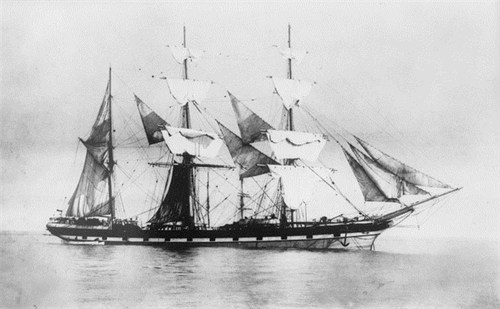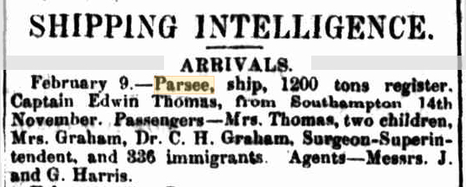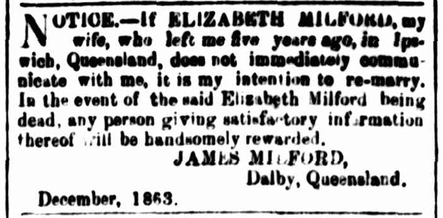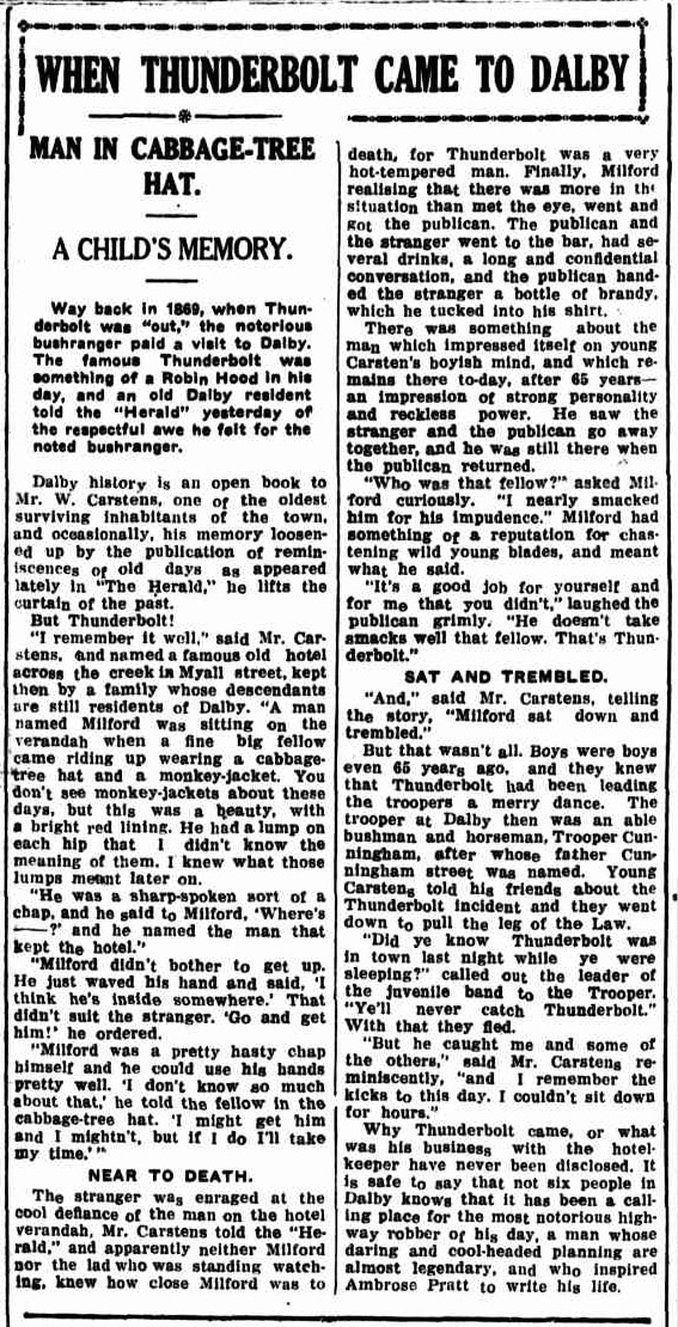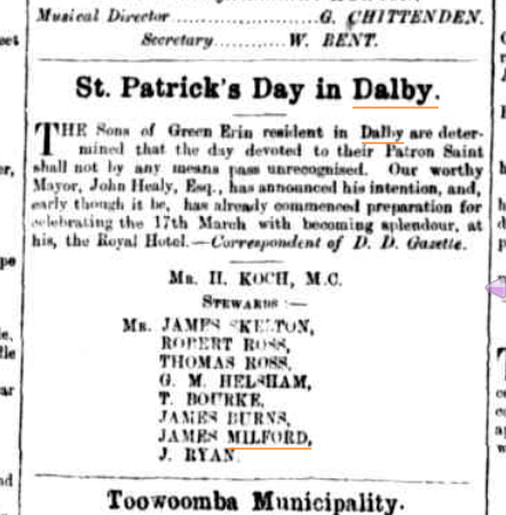1853 Milford - Brown marriage banns. James lived at 12 Tottenham St, Balls Pond.
James Milford 1831 - 1916
|
The Parsee
|
17 Feb 1857 The immigration ship, Parsee, arrived, with James Milford (26) and his wife of 4 years, Elizabeth (26) on board.
James was the eldest of at least 8 children. He followed in his father's footsteps and became a carpenter. His brother Henry (1840 - 1892) was transported to Western Australia as a convict. James and Elizabeth, both Londoners, lived in the Ipswich area and separated in 1858. The Dalby Herald reported in 1915 that James arrived in Dalby in 1859. Elizabeth either entered a relationship with another man, or returned to England, or relocated elsewhere in Australia. There is no record that James and Elizabeth Milford had any children. James married Catherine McLaren in 1864. They had 3 sons and 2 daughters who presented them with 27 grandchildren. Catherine had 2 sons by her first marriage to Walter Goodman. It is possible that James had met the McLaran family, and subsequently Catherine, in Ipswich between 1857 and 1859. |
Feb 1857 Parsee passenger list.
James Milford (25) recorded as a carpenter from London, his parents were James Milford and Catherine Hoy. His wife Elizabeth (26) was also from London and her parents were James and Sophia Brown. Both James and Elizabeth could read and write and were of sound health.
James Milford (25) recorded as a carpenter from London, his parents were James Milford and Catherine Hoy. His wife Elizabeth (26) was also from London and her parents were James and Sophia Brown. Both James and Elizabeth could read and write and were of sound health.
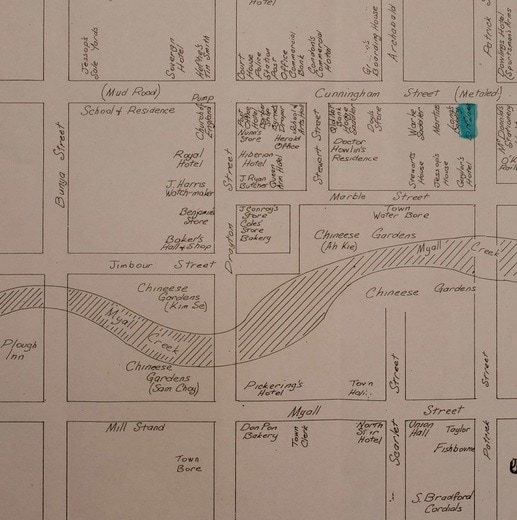
Aug 1863 James Milford and the Dalby Dramatic Society
29 Aug 1863 The Courier
DALBY DRAMATIC SOCIETY.
The Dalby Amateur Dramatic Society gave two performances, on the evenings of the 19th and 20th instant, in the Union Hall (see comment below), which has been fitted up as a stage. "Schinderhannes, or, the Robber of the Rhine," was the leading piece. After which, the farce of the "Unfinished Gentleman."
The scenery, which was entirely new, was of the most elaborate description; and whether we refer to the drop scene, to the picture of Shakespeare, the nymphs at the sides pouring water or oil from vases over their heads, the appropriate motto above the curtain, or the mountains on the Rhine with the castle and water in the distance, all showed the work of an artist.
Where all were so good and strove so hard to please, it would be invidious to particularize; but we cannot refrain from alluding to the first rate personification of the Robber, by Mr. Estaughffe (who generally does the heavy father business); both by dress, voice and gesture, he well sustained the character of a perfect ruffian. Mr. Milford, as Count Aymeric, in military costume, with cocked hat, feathers, and sword, acted his part to perfection; whilst Mr. Bradly, as Sir Guyman Guffin, evidently showed he was no novice to the sock and buskin; and Mr. Miller, as the Hag of the Tomb, well sustained his character.
The tableaux vivants, where the Hag shows the Count and the Robber the history of their past lives, were works of art. Mr. Goodfellow, as the Unfinished Gentleman, kept the house in roars of laughter; as an inimitable low comedian he is most promising. Mr. Warren's get up, voice, manner, and gesture, as Miss Charity, was true to nature. The house was crammed to suffocation, and the greatest cheerfulness and good humour prevailed; pipes and cigars were only allowed in the gallery; whilst neighbor Klein, whether as Jacob in the leading piece, or as caterer afterwards to the public appetite, gave very great satisfaction.
Comment
The Union Hall was located on the corner of Scarlet & Myall Streets - see map. It was a timber structure built as a wool store by Charles Douglas Eastaughffe (see above - he arrived in Dalby around 1854) and then converted to a theatre. The hall burnt down many years ago.
29 Aug 1863 The Courier
DALBY DRAMATIC SOCIETY.
The Dalby Amateur Dramatic Society gave two performances, on the evenings of the 19th and 20th instant, in the Union Hall (see comment below), which has been fitted up as a stage. "Schinderhannes, or, the Robber of the Rhine," was the leading piece. After which, the farce of the "Unfinished Gentleman."
The scenery, which was entirely new, was of the most elaborate description; and whether we refer to the drop scene, to the picture of Shakespeare, the nymphs at the sides pouring water or oil from vases over their heads, the appropriate motto above the curtain, or the mountains on the Rhine with the castle and water in the distance, all showed the work of an artist.
Where all were so good and strove so hard to please, it would be invidious to particularize; but we cannot refrain from alluding to the first rate personification of the Robber, by Mr. Estaughffe (who generally does the heavy father business); both by dress, voice and gesture, he well sustained the character of a perfect ruffian. Mr. Milford, as Count Aymeric, in military costume, with cocked hat, feathers, and sword, acted his part to perfection; whilst Mr. Bradly, as Sir Guyman Guffin, evidently showed he was no novice to the sock and buskin; and Mr. Miller, as the Hag of the Tomb, well sustained his character.
The tableaux vivants, where the Hag shows the Count and the Robber the history of their past lives, were works of art. Mr. Goodfellow, as the Unfinished Gentleman, kept the house in roars of laughter; as an inimitable low comedian he is most promising. Mr. Warren's get up, voice, manner, and gesture, as Miss Charity, was true to nature. The house was crammed to suffocation, and the greatest cheerfulness and good humour prevailed; pipes and cigars were only allowed in the gallery; whilst neighbor Klein, whether as Jacob in the leading piece, or as caterer afterwards to the public appetite, gave very great satisfaction.
Comment
The Union Hall was located on the corner of Scarlet & Myall Streets - see map. It was a timber structure built as a wool store by Charles Douglas Eastaughffe (see above - he arrived in Dalby around 1854) and then converted to a theatre. The hall burnt down many years ago.
|
Dec 1863 James Milford placed a series of notices in Queensland newspapers alerting his wife Elizabeth (whereabouts unknown) to his marriage intentions.
17 Dec 1863 Brisbane Courier NOTICE. ELIZABETH MlLFORD, my wife, who left me five years ago, in Ipswich, Queensland, does not immediately communicate with me, it is my intention to re-marry. In the event of the said Elizabeth Milford being dead, any person giving satisfactory information thereof will be handsomely rewarded. |
Comment
Milford's notices probably indicated his intent to marry Catherine.
Milford's notices probably indicated his intent to marry Catherine.
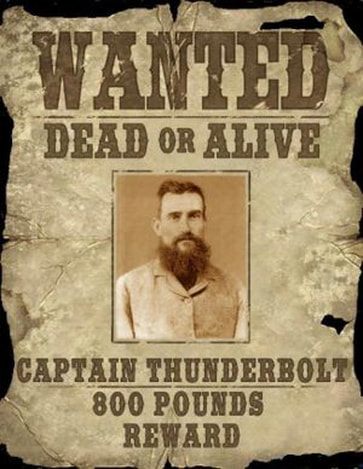
1864 Captain Thunderbolt attended a Dalby dance.
4 Apr 1924 Dalby Herald
The new Plough Inn gained a imputation as the "toff" hotel of Dalby, its deep morticed stumps may still be seen, and one at least of its decorated fence posts, while at the path-side is the slab of stone that formed its entrance. Behind the Plough inn, in Bunya street, an opposition hostelry raised its head in the form of the "Red Lion." The whole of this corner, then known as the "Old Corner," passed subsequently into the hands of the R.C. Church, and was used for some years as the convent.
A story is told of Walker, the bushranger (known as Thunderbolt), appearing like an apparition at the door of the hall, which was in charge of Jim Milford, during the progress of a dance, and armed, cap-a-pie, Walker demanded to have the M.C. (Mr. Estaughffe), sent out to him and ordered him to hand over bottles of brandy to the freebooter. If true, the story adds a tinge of romance to the Old Corner.
4 Apr 1924 Dalby Herald
The new Plough Inn gained a imputation as the "toff" hotel of Dalby, its deep morticed stumps may still be seen, and one at least of its decorated fence posts, while at the path-side is the slab of stone that formed its entrance. Behind the Plough inn, in Bunya street, an opposition hostelry raised its head in the form of the "Red Lion." The whole of this corner, then known as the "Old Corner," passed subsequently into the hands of the R.C. Church, and was used for some years as the convent.
A story is told of Walker, the bushranger (known as Thunderbolt), appearing like an apparition at the door of the hall, which was in charge of Jim Milford, during the progress of a dance, and armed, cap-a-pie, Walker demanded to have the M.C. (Mr. Estaughffe), sent out to him and ordered him to hand over bottles of brandy to the freebooter. If true, the story adds a tinge of romance to the Old Corner.
18 Aug 1933 Thunderbolt's visit is recounted in more detail.
This 1933 story about Thunderbolt and James Milford provides an insight to the character of the young James Milford. The Thunderbolt story was recounted incorrectly in the 20th century.
This 1933 story about Thunderbolt and James Milford provides an insight to the character of the young James Milford. The Thunderbolt story was recounted incorrectly in the 20th century.
Court of petty debts
15 Jul 1865 Dalby Herald
On Tuesday, the court of petty debts was held. There were a large number of cases to be heard, in consequence of Mr. T. Ross giving up business as a butcher, and therefore appealing to law in order to enforce his claims on certain very long winded customers. These cases were not defended, so judgment was entered for the plaintiff. Milford v. Koch, in which plaintiff was to sue for balance due on contract for building Brown's hotel, was the only case of interest; but it did not come off, plaintiff not appearing.
Comment
It was common practice to take one’s grievances to the Dalby court. Businessman and self-titled King of Dalby, F.W. Roche, spent a lot of time in court pursuing monetary claims. Around this time Roche issued his own currency and at one stage bought up official Queensland Government notes at half their face value.
15 Jul 1865 Dalby Herald
On Tuesday, the court of petty debts was held. There were a large number of cases to be heard, in consequence of Mr. T. Ross giving up business as a butcher, and therefore appealing to law in order to enforce his claims on certain very long winded customers. These cases were not defended, so judgment was entered for the plaintiff. Milford v. Koch, in which plaintiff was to sue for balance due on contract for building Brown's hotel, was the only case of interest; but it did not come off, plaintiff not appearing.
Comment
It was common practice to take one’s grievances to the Dalby court. Businessman and self-titled King of Dalby, F.W. Roche, spent a lot of time in court pursuing monetary claims. Around this time Roche issued his own currency and at one stage bought up official Queensland Government notes at half their face value.
Over the years, James Milford assisted at many accidents.
12 Jan 1867 Dalby Herald
Fatal Accident.
A lamentable accident resulting in the death of a boy, about fourteen years of age, named James Fitzpatrick, occurred on Monday last. Fitzpatrick was employed to cut wood and draw water for Messrs. Anderson and Twine, and about eight o'clock on the morning of the day in question was in the act of landing the bucket of water after winding it up when it is supposed his feet slipped from under him and he fell down the well, the back of his head coming in contact with the landing floor.
No one saw the boy fall, but the noise of the windlass and a splash attracted the attention of Mr. Twine, who hurried out of his house to learn the cause, and not seeing the boy, who was known to have been at the well just previously, an alarm was raised.
Mr. Milford, carpenter, went to the spot and descended the well, when the boy was found, quite insensible. On being brought to the surface it was found that he had sustained a severe fracture on the back of the head. He was put in a fast bath, and various remedies applied, but he showed no signs of life. On the arrival of medical aid the boy was dead. The well is eighty feet deep. On Tuesday morning a magisterial inquiry was held by F. W. Roche, Esq., J.P.
Comment
In 1867 W.R. Twine was the mayor of Dalby. His nephew, Joseph White Twine, married Agnes Sullivan, daughter of Margaret McLaren & Denis Sullivan. W.R. Twine's brother, Robert Cumberland Twine, leased 640 acres beside Donald McLaran's selection, Frogmore, at Wabba Ridges.
12 Jan 1867 Dalby Herald
Fatal Accident.
A lamentable accident resulting in the death of a boy, about fourteen years of age, named James Fitzpatrick, occurred on Monday last. Fitzpatrick was employed to cut wood and draw water for Messrs. Anderson and Twine, and about eight o'clock on the morning of the day in question was in the act of landing the bucket of water after winding it up when it is supposed his feet slipped from under him and he fell down the well, the back of his head coming in contact with the landing floor.
No one saw the boy fall, but the noise of the windlass and a splash attracted the attention of Mr. Twine, who hurried out of his house to learn the cause, and not seeing the boy, who was known to have been at the well just previously, an alarm was raised.
Mr. Milford, carpenter, went to the spot and descended the well, when the boy was found, quite insensible. On being brought to the surface it was found that he had sustained a severe fracture on the back of the head. He was put in a fast bath, and various remedies applied, but he showed no signs of life. On the arrival of medical aid the boy was dead. The well is eighty feet deep. On Tuesday morning a magisterial inquiry was held by F. W. Roche, Esq., J.P.
Comment
In 1867 W.R. Twine was the mayor of Dalby. His nephew, Joseph White Twine, married Agnes Sullivan, daughter of Margaret McLaren & Denis Sullivan. W.R. Twine's brother, Robert Cumberland Twine, leased 640 acres beside Donald McLaran's selection, Frogmore, at Wabba Ridges.
Feb 1865 Dalby Herald
James Milford was prominent in community affairs.
James Milford was prominent in community affairs.

16 Dec 1916 James Milford death
23 Dec 1916 Dalby Herald
The death occurred on Thursday night of Mr. James Milford, an old identity of Dalby, at the advanced age of 86 years (writes our Dalby correspondent). The deceased was a native of London, and had been resident in Queensland for about 60 years. He was married in Dalby to Miss (incorrect – Mrs) Catherine Goodman, and his wife predeceased him by five (incorrect – 3) years. He leaves a family of three sons (James, Henry, and Donald) and two daughters (Mrs. Jas. Ryan and Mrs. Jas Connell). The interment took place at the Dalby cemetery on Friday afternoon, the Rev. R. Millar (in the absence of the Rev. B. P. Walker) conducting the service at the graveside.
23 Dec 1916 Dalby Herald
The death occurred on Thursday night of Mr. James Milford, an old identity of Dalby, at the advanced age of 86 years (writes our Dalby correspondent). The deceased was a native of London, and had been resident in Queensland for about 60 years. He was married in Dalby to Miss (incorrect – Mrs) Catherine Goodman, and his wife predeceased him by five (incorrect – 3) years. He leaves a family of three sons (James, Henry, and Donald) and two daughters (Mrs. Jas. Ryan and Mrs. Jas Connell). The interment took place at the Dalby cemetery on Friday afternoon, the Rev. R. Millar (in the absence of the Rev. B. P. Walker) conducting the service at the graveside.
Comments
- James Milford's death certificate (part above) contains many errors in ages and spellings. James was married twice and 34 years of age when he and Catherine Goodman (nee McLaren) married in 1864.
- Presbyterian minister, Robb Millar, officiated at the graveside.
- The christian names of both Catherine McLaren and Catherine Milford were often spelt "Katherine" and Catherine McLaren was sometimes known as "Kate".
- James' obituary failed to mention the significant contribution he and his family made to the lives of the citizens of Dalby over a very long period, or that he had lost a grandson at Gallipolli in 1915.
Questions and (possible) Answers:
Q1. What became of James Milford's first wife, Elizabeth Brown?
A1. It is likely that Elizabeth left James and either returned home or moved to another colony.
Q2. Was James community-minded?
A2. James Milford was involved in numerous community affairs in Dalby. The eldest of at least 8 children, he responded well in times of emergencies.
Q3. What was James Milford's legacy?
A3. James Milford's legacy included:
Q1. What became of James Milford's first wife, Elizabeth Brown?
A1. It is likely that Elizabeth left James and either returned home or moved to another colony.
Q2. Was James community-minded?
A2. James Milford was involved in numerous community affairs in Dalby. The eldest of at least 8 children, he responded well in times of emergencies.
Q3. What was James Milford's legacy?
A3. James Milford's legacy included:
- a large and versatile family who excelled in many pursuits (music, football, cricket, boxing, horse racing, swimming, basketball) and occupations. Today, his descendants are spread over South East Queensland.
- the number of descendants of Catherine McLaren & James Milford rivals the number of descendants of Margaret McLaren and Donald McLaran.
- 3 grandsons who fought in World War 1 and 2 at Gallipoli, where Walter Milford was buried.
- grandsons Henry and Jimmy (Leonard James) Milford were involved in horse racing, Henry as owner-trainer and Jimmy as jockey. Jimmy regularly competed against Jane Rider's grandson, the famous amateur jockey, Tom Kennedy.

